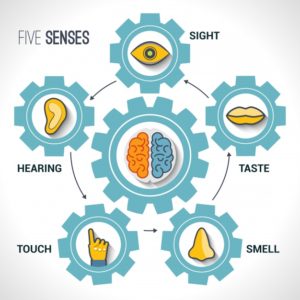There are seven different learning styles even though we have 5 senses. Most students fall across the spectrum of each of these styles. Some may be visual and spatial learners, while others are aural and musical learners. As there are various types of learners, it is not easy to stimulate learning for all students through just one learning method.
Seven Different Learning Styles
- Visual: Representing information spatially through pictures, models, or colors.
- Kinaesthetic: Doing things physically and following a hands-on approach.
- Aural: Retaining information after hearing it.
- Verbal: Understanding through words such as acronyms, tongue twisters, or rhymes.
- Logical: Using numbers, calculations, or structure.
- Social: Participating in study groups and testing one another.
- Solitary: Studying alone, making flashcards, and reciting back to self.
Multisensory Learning
“I hear, and I forget. I see, and I remember. I do, and I understand.”
This old Chinese proverb sheds light upon the importance of our five senses in the process of learning. Seeing, hearing, touching, tasting, and smelling help us discover new information. When we use all five senses together to learn, we follow the approach of Multisensory Learning. Students, no matter the age, learn best when mixed with experience. In a report by D.G. Treichler, as cited in the journal “Trends in Cognitive Sciences,” he revealed that “Students remember 10% of what they read, 20% of what they hear, 30% of what they see, and 50% of what they see and hear.” The better they are at combining their senses, the more they can remember what they have learned (Shams & Seitz 2008).
Over the years, an abundance of research tells us that parts of our brains communicate with each other. Micah Murray, an Associate Professor at the University of Lausanne, Switzerland, illustrates this with an example of speech. When you hear another person speaking in your native language, you do not need to watch it being spoken to understand. However, if you are not comfortable with the language, you tend to look at the speaker’s mouth to understand the words. Two of our senses work together to help us understand and learn (Gordon, n.d.).
Two second-grade teachers had a difficult time teaching science to their students. They believed it was tough to teach science at such a young age. They came up with a solution: To teach them about the different properties of matter, they decided to do a small science experiment. They collected items that resembled solids, liquids, and gases. Students then had to place each item under each category. To their surprise, students took their turns and correctly categorized their selected items. Through this exercise, the teachers saw an increase in engagement and wanted to learn more about Multisensory Teaching (Stoffers, 2011).
They then came across a study conducted at Rowan University, New Jersey. The study attempted to understand the effect of Multisensory Teaching on students’ academic achievement. Lessons plans targeting multiple senses and team-building activities were implemented for second-grade students. Primary research was collected through focus groups, interviews, and journals. The data revealed that Multisensory Teaching improves student motivation and engagement. The second-grade students used the words “fun” and “exciting” when describing the multisensory classroom. Through this approach, the use of technology and making connections was also taught in the right manner. One fascinating insight came out of this study: Using a learning approach that incorporates all five senses encourages students who have been silent within traditional classroom settings. It helped shy students become more interested in the classroom and show their enthusiasm (Stoffers, 2011).
Connection With Experiential Learning
Compared to Multisensory Learning, Experiential Learning also follows a similar process of using hands-on learning and science experiments to help students reflect on what is being taught. Learning theory that uses real-world examples incorporates our senses. At ExperiHub, we believe that imparting education through Experiential Learning raises students’ scientific curiosity. We conduct science projects for better learning that activates the brain to develop the necessary skills needed to grasp concepts better. To learn more about Experiential Learning, please feel free to go through our Online Sessions and Workshops. Let us make learning fun with cool home experiments!
For science related videos : https://www.youtube.com/c/ExperiHub?sub_confirmation=1
References:
Shams, Ladan, and Aaron R. Seitz. “Benefits of Multisensory Learning.” Trends in Cognitive Sciences, vol. 12, no. 11, 2008, pp. 411–417., doi:10.1016/j.tics.2008.07.006.
Stoffers, Melissa. pp. 1–97, Using a Multi-Sensory Teaching Approach to Impact Learning and Community in a Second Grade Classroom.
“What Are The 7 Different Learning Styles And Do They Work?” Avado, 16 Apr. 2020, www.avadolearning.com/blog/the-7-different-learning-styles-and-what-they-mean/.


